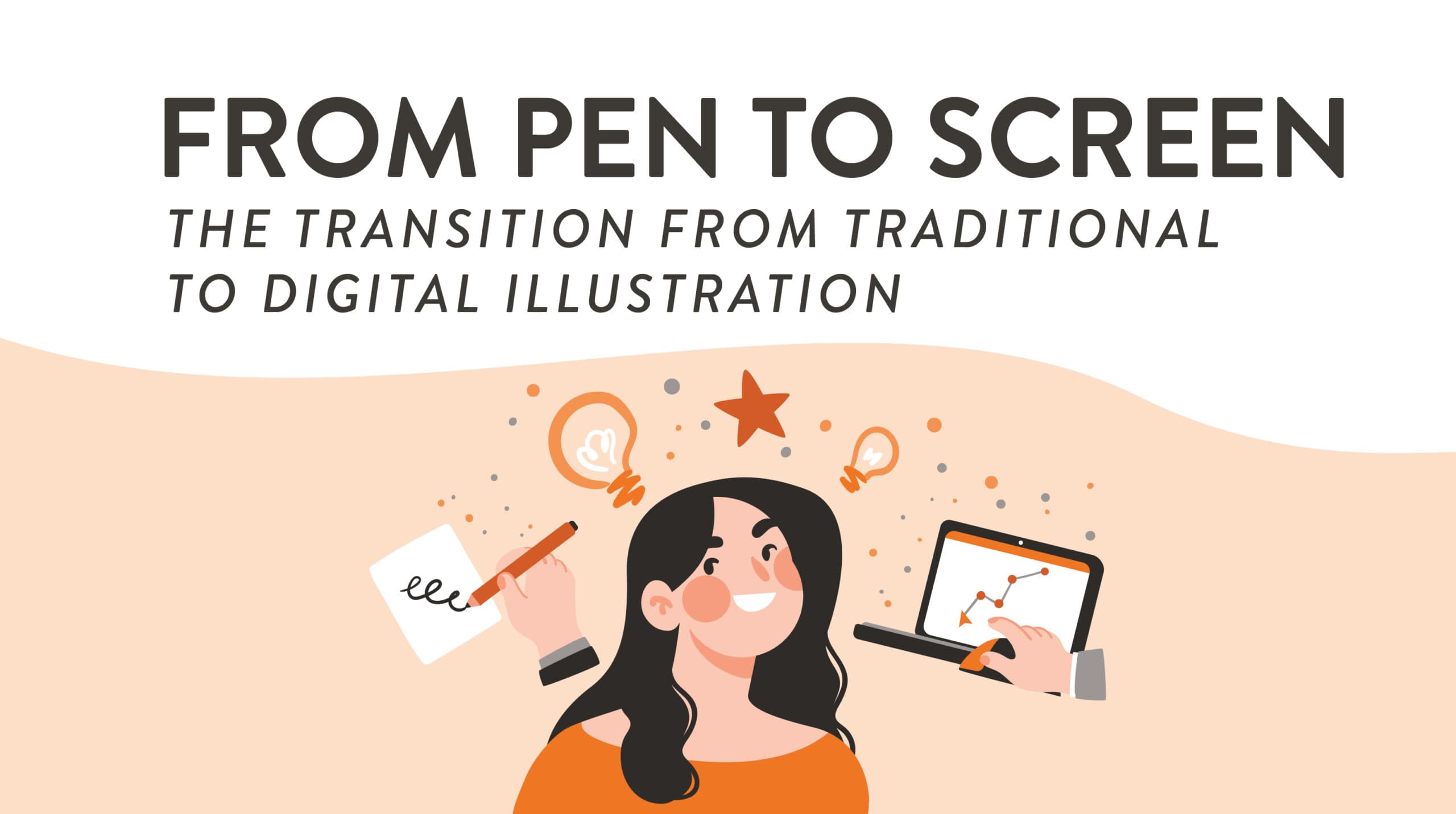When you think of illustration, you might think of children’s books or comic strips. Depending on when you grew up, these creations may have been illustrated by hand using pen and paper or by newer computer technology. In this blog, we will go over both techniques, the pros and cons of each, and the history behind the transition from traditional to digital illustration.
What is Digital Illustration?
Before we define digital illustration, let’s define illustration. Merriam-Webster defines an illustration as “a picture or diagram that helps make something clear or attractive.” Thus, a digital illustration is exactly what it sounds like, a picture or diagram created using digital technology. These images can be found in children’s books, comics, or safety manuals – the possibilities are endless.
Traditional Illustration Techniques
Countless traditional illustration techniques have been developed throughout history. The techniques below are among the most influential in the illustration world and provide a strong overview of traditional illustration.
- Pen and Ink
Dating back centuries, pen and ink were the prevailing way to create illustrations. While this technique allowed illustrators to draw anything they could imagine, there were several key drawbacks – it was time-intensive, repetitive, and ink often smudged. Advancements in technology have assisted pens to stay relevant well into the present – including colored pens, erasable ink, and lightboards.
- Watercolor Illustration
Watercolors are a type of unique pigment that allows painters and illustrators to create images by adding water and brushing the pigment onto paper. Watercolor illustration has become synonymous with beautiful landscapes and pastel color palettes, however there is much diversity within the art form. Watercolor painting can be difficult because the pigment can flow across the paper in unpredictable ways and it is difficult to paint over without darkening the illustration.
- Acrylic Gouache
Acrylic gouache is a form of paint similar to watercolor but made from an acrylic base that gives the pigment a more vibrant matte appearance. However, acrylic gouache does not have the same properties as acrylic paint. Many illustrators will water it down to create more muted tones while others prefer the standard vibrancy. Acrylic gouache is commonly used by illustrators because it easily adheres to various surfaces and is waterproof when dry.
Advantages of Traditional Illustration
Many artists believe that traditional illustration boasts several advantages over digital illustration. While these preferences are subjective, it is important to note that they are significant enough to have an impact on the illustration industry as a whole.
- Tangible and Authentic Feel
While authentic feel is subjective, many describe something as authentic when it has a unique quality that only that artist or medium could give it. Additionally, describing artwork as tangible may sound confusing when discussing a 2D illustration. However, tangibility can also be defined as “capable of being precisely identified or realized by the mind.” In both cases, these words are used to describe the precise degree of mastery a traditional illustrator has over their artwork and tools.
- Unique Textures and Imperfections
Whether it is sketch marks from previous drafts, unintentional coloring, or ink smudges–Many artists embrace these imperfections. Many consider these variations to be an important part of the drawing because they give insight into how an illustration was created.
- Historical Significance
Traditional illustration has a long and important history that continues to inform today’s illustration techniques, as well as other mediums. Dating as far back as cave paintings, illustration is one of humankind’s oldest art forms and thus has given us the outlet to describe our existence for millennia. While digital illustration also has a rich and fascinating history, it is a much more recent art form that has not had the same amount of time for artists to explore and pioneer the medium.
Considerations of Traditional Illustration
Traditional Illustration is however not without its drawbacks. Like any art form, these considerations may prove minor or major depending on the preferences of the artist.
- Limited Undo Options
A major pain point for traditional illustrators is that mistakes are costly. If an illustrator is unhappy with a part of a drawing, then they might attempt to erase that section, however marks may still be left on the page. If a mistake is too large or cannot be erased, then an illustrator may be forced to start from square one. The benefit of digital illustration is that illustrators can simply click the undo button and revert the illustration to an earlier version. This feature is helpful when deciding whether or not to include an element you may be on the fence about.
- Time-Consuming Process
In traditional illustration, there is much more redundancy to the craft. Meaning, if 25 images of the same character have to be illustrated in 25 different poses, then a traditional illustrator will likely have to completely redraw all 25 poses. With digital illustration, the illustrator might have the same task, but can easily copy their character into a new image and make minor adjustments to accommodate the different versions needed. While it is far more time-consuming to illustrate in the traditional method, many advocates for this style believe it promotes a “practice makes perfect” attitude and challenges illustrators to hone their craft.
Digital Illustration Techniques
Digital illustration techniques vary between different artists and software platforms, many artists dabble in multiple techniques and some even combine these practices. Here are a couple of the techniques that are most widely used by illustrators!
- Digital Painting
While digital illustration and digital painting are similar, illustration pays more attention to line work, while painting is more concerned with color and shading. When combined, these practices create a final piece of artwork, thus many illustrators paint and many painters illustrate. However, certain projects may be split between a digital illustrator and a digital painter.
- Vector Illustration
Vector illustration uses geometric shapes to create a final product. This process allows illustrators to focus on positioning and composition. Oftentimes, vector illustrations are used to create flatter images, such as logos and infographics. They don’t typically rely on shading, gradients, and depth.
Advantages of Digital Illustration
Digital illustration also has several advantages over traditional illustration. Most significantly, digital illustration has made advancements to make illustrating easier. The advantages listed below are just a couple of examples of how digital illustration helps artists.
- Versatility and Flexibility
With quickly advancing technology, illustrators can now work on their art wherever they go! With a laptop or graphic tablet, digital illustrators can work on much larger projects, than traditional illustrators who may be weighed down by the different inks, pens, and paints. This makes it easier for digital illustrators to work while traveling or commuting.
- Collaboration and Sharing
Many artists feel as though they cannot be successful in their creative process without some degree of feedback or collaboration. Luckily, for digital illustrators, this process has never been easier. The internet allows creatives to easily share images of their work either with specific individuals or whole communities on social media. This is great for illustrators seeking feedback during projects as well as showing off the final product.
Considerations of Digital Illustration
Digital illustration also has particular drawbacks that can make producing illustrations difficult or impossible. However, learning about the considerations such as the ones below can help you avoid certain pitfalls.
- Software Learning Curve
Learning new programs such as Adobe Illustrator and Adobe Photoshop can be difficult. Layouts are different, features may vary, and it’s hard to not waste time with inefficient practices when you don’t know a software’s shortcuts. Luckily, there are resources to help shorten the learning curve like YouTube and LinkedIn Learning. Learning can be frustrating, but as you continue to practice you will continue to improve.
- Technology Dependency
The largest drawback to digital illustration is technology dependency. We have all forgotten to save a document, imported the wrong file, or misplaced a charger. All of these issues may seem small or avoidable, but it is important to be aware of these drawbacks when illustrating digitally. If you are prepared for these problems, then you will save yourself a lot of time and stress.
Examples of Prominent Digital Illustrations
To provide you with a better understanding of the full breadth of what digital illustration can look like, we have included the following examples of prominent digital illustrations. These artists showcase diverse styles and techniques discussed in this article.
Alex Gross’ Editorial Illustrations
Alex Gross is a digital illustrator whose work blends commercial and surreal elements. Their mixed-media approach to illustration often utilizes both digital and traditional forms of illustration as well as vintage photography, and oil painting. Gross’ style capitalizes on the best of both worlds when it comes to illustration.
Victo Ngai’s Book Covers
Victo Ngai’s book covers are sleek yet eye-catching. She creates unique textures and imperfections with the illusion of brush strokes. Victo’s work is likely a combination of vector imagery and digital painting. Because of her mastery of illustration, she has collaborated with multiple book publishers and dozens of other household names.
Tips for Transitioning to Digital Illustration
While there is no foolproof way to pick up a new art medium, there are certain tips that can help you improve as a digital illustrator. It is incredibly helpful to have a high-quality drawing tablet or computer, so make sure to do some research before making a purchase. Similarly, learn about the drawbacks and advantages of different digital illustration programs such as Adobe Illustrator and Adobe Photoshop. Many illustrators have different preferences when it comes to software, but it is always advantageous to learn multiple programs. Learning new techniques will allow you to create your own unique style. Next, study the techniques of other illustrators regardless of their specialty. Finally, no matter how many of these tips you follow, there is one step you cannot skip, practice. Practice is the most important part of learning anything new, so do not be afraid to experiment and make mistakes!
Want To Learn More?
To learn more about illustration, check out RMCAD’s illustration program, available on campus and online. If you would like to read more blogs about illustration, we recommend 5 illustration careers you can pursue with a bachelor’s degree.

